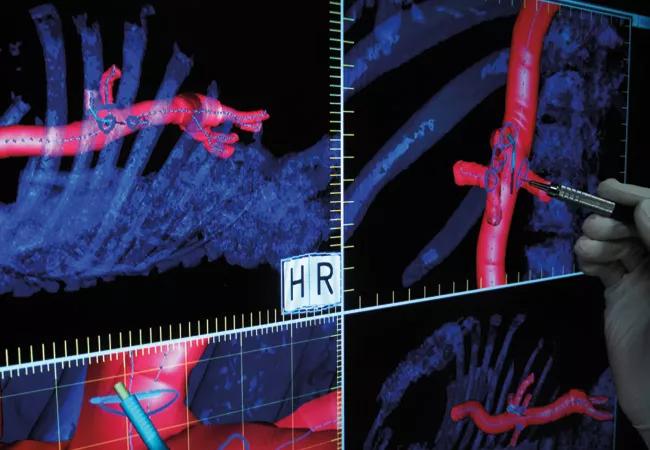Endovascular navigation technology clears first preclinical study

Endovascular repair of aortic aneurysms and dissections is critically dependent on optimal understanding of the patient’s vasculature. To that end, Cleveland Clinic Innovations spinoff company Centerline Biomedical Inc. is refining development of its Intraoperative Positioning System (IOPS), a novel endovascular navigation technology developed by Cleveland Clinic researchers.
Advertisement
Cleveland Clinic is a non-profit academic medical center. Advertising on our site helps support our mission. We do not endorse non-Cleveland Clinic products or services. Policy
IOPS extracts the centerlines of the aorta and branch vessels from a patient’s CT and then mathematically constructs a high-quality three-dimensional model of the relevant vasculature, as shown in the image above. Electromagnetic tracking technology allows the model to be used in a GPS-like fashion to guide surgeons during minimally invasive endovascular aortic repairs, enabling less reliance on X-ray fluoroscopy.
The first preclinical in vivo study of IOPS was completed in May 2016 at Cleveland Clinic Lerner Research Institute. It demonstrated the system’s ability to provide non-radiation-based navigation with superior visualization compared with X-ray fluoroscopy, which is limited by its two-dimensional visualization and by the radiation exposure it confers on patients and providers.
“Preclinical evaluation verified the ability to use this navigation system in manipulating through the aorta and its branches in the absence of radiation-inducing fluoroscopy,” says Cleveland Clinic vascular surgeon Matthew Eagleton, MD, who led the study. Noting that catheters and guidewires were easily visualized on the IOPS display, he predicted that the system “will be a game changer in the era of endovascular therapy.”
Centerline Biomedical plans to submit IOPS for FDA review, with a target market entry in the third quarter of 2017.
Advertisement
Advertisement

Why Cleveland Clinic is launching its cardioimmunology center

End-of-treatment VALOR-HCM analyses reassure on use in women, suggest disease-modifying potential

New Cleveland Clinic data challenge traditional size thresholds for surgical intervention

3 specialists share multidisciplinary perspectives on a widely impactful cardiovascular condition

Experience-based takes on valve-sparing root replacement from two expert surgeons

Two surgeons share insights on weighing considerations across the lifespan

Join us in Florida this winter for a long-standing CME favorite

BITA grafts themselves are rarely to blame, and outcomes can be good